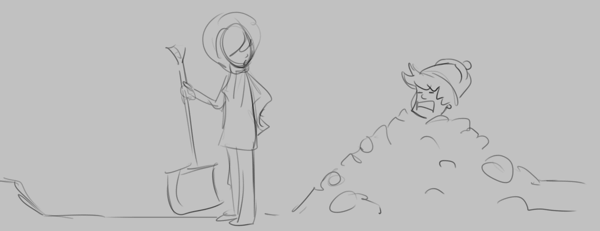Creating a Comic Sketch
So you want to become an illustrator, eh? Well, in learning any skill the first thing someone will tell you is to practice everyday. And boy is it important! With dedicated practice comes a lot of repetition. As a comic illustrator, you’ll frequently work with sequences and create characters or environments over and over again, so it is vital that you draw something you are passionate about.
It’s okay to draw subjects from artists who inspire you. In fact, it is one of the easiest ways to get started. My brother and I were inspired by Charles Schulz’s comic strip, Peanuts, when thinking about what to do for our comic. The linear format and natural character interactions appealed to us, and the black and white color palette is reminiscent of old newspaper comic art and traditional drawing.
Let’s get started!
The Sketch
Whether you prefer starting on paper or digitally, the importance of sketching out your idea remains the same. Sketching creates a foundation in which all other elements fall into place – scene composition, character or subject emphasis – and ultimately determines how the story will be told. But fret not! Your sketches do not have to be perfect. Simple lines and shapes can be built upon later.
Illustrations by Ryan Czepiel

The Line Art
Where are my manners? I didn’t introduce the two characters who will be accompanying us on our small journey of drawing comics. Meet Sabi and Ginge, best friends in a series that portrays their funny, often awkward social interactions and mischievous adventures.
When you are finished with a sketch that shows your scene in it’s entirety, then you can open it in a program of your choosing to refine the line work (if you don’t prefer working in pen and ink). Being a vector-based program I prefer Adobe Illustrator to draw contours instead of Adobe Photoshop because it produces much cleaner lines without sacrificing quality if you decide to adjust the size. In Illustrator I use a 3.pt and 5.pt oval brush. Working on a Wacom tablet allows me to change the line thickness the harder I press on the tablet. So drawing softly will create thin lines and pressing harder will create heavy lines. By no means is this “the way” to go about creating line art! The best thing about continuous practice is that you’ll develop your own methods that will allow you to work more comfortably.
![]()

Coloring
Next we can start coloring. Illustrator is certainly a capable tool to color in your work, but I prefer exporting my line art as a psd because I prefer the blending and finesse that Photoshop offers when painting. In Photoshop I then start blocking in the basic colors for Sabi and Ginge. Luckily we are only working with grayscale and you’ll notice that we use 4 colors, including white. Since we’re working with solid colors for this phase, it’s okay to get a little messy. Use the eraser tool to clean up edges once the color is blocked in.

Finishing Touches
Once you have the basic colors filled in, you can start adding a bit more detail to the characters. This includes shadows and gradients. Using a darker gray, and adjusting either the brush opacity or clicking the brush transparency icon will allow you to create lighter brush strokes for shading or blending. You can then apply a gradient to the background to complete the scene. As a bonus sometimes I’ll add small filters such as gaussian blurs to the line art layer so that the contrast between the black and white isn’t so sharp. Feel free to add dialogue clouds for extra fun!

There You Have It!
Now that you know the basics in creating a comic illustration, you can further improve as an artist by learning the fundamentals and best approaches of both drawing and comic art through daily practice. Remember to always consider the reader when creating comics, but also draw what you are passionate about. Don’t shy away from your ideas, embrace them through creative drawing!




